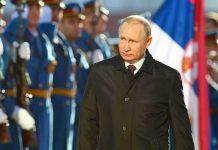
Russia’s massive nuclear modernization program has been fully exposed through an unprecedented security breach, revealing detailed blueprints, security systems, and strategic capabilities of Putin’s most sensitive military installations.
Key Takeaways
- Over two million sensitive documents detailing Russia’s nuclear modernization plans were found in a publicly accessible database, exposing extensive information about missile sites and infrastructure.
- The breach reveals detailed blueprints of strategic nuclear bases, including the Yasny site which houses the advanced Avangard hypersonic glide vehicle.
- Leaked documents show Russia’s efforts to renovate Soviet-era bases and build new facilities with modern security systems including electric fencing, sensors, and explosion-resistant doors.
- Military experts describe this as “a huge breach of security” that provides unprecedented intelligence about Russia’s nuclear capabilities and vulnerabilities.
- The documents expose Western companies’ materials being used in these sensitive military installations despite sanctions and export restrictions.
A Catastrophic Security Failure
In what security experts are calling one of the most significant intelligence leaks in recent history, over two million classified documents detailing Russia’s nuclear modernization program have been discovered in a publicly accessible database. The breach exposes the inner workings of Russia’s most sensitive military sites, including the strategic missile base near Yasny in the Orenburg region, which houses Russia’s advanced Avangard hypersonic glide vehicle. Danish outlet Danwatch and German magazine Der Spiegel conducted a joint investigation that uncovered architectural plans, internal layouts, security protocols, and procurement records that were never meant to see the light of day.
“More than two million sensitive documents found in a publicly accessible database have revealed extensive details about the modernization and expansion of Russia’s nuclear weapons infrastructure, according to an investigation published Wednesday by Danish outlet Danwatch and German magazine Der Spiegel,” Stated Der Spiegel
Norwegian military expert Tom Røseth described the leak as “a huge breach of security” that “appears to me very credible and the immense scope of it is impressive.” This unprecedented exposure reveals not just Russia’s nuclear capabilities but also potentially critical weaknesses in these systems. While Russia has tightened laws regarding access to military records, officials from Russian military construction companies apparently continued sharing secret documents in public databases, demonstrating a shocking level of incompetence in protecting their most sensitive national security information.
Inside Russia’s Nuclear Infrastructure
The leaked documents provide extraordinary details about Russia’s nuclear facilities, offering Western intelligence an unprecedented look into Moscow’s strategic capabilities. The documents detail comprehensive construction designs for new barracks, guard towers, command centers, storage buildings, and underground tunnel networks. Security systems are meticulously outlined, including electric fencing, motion sensors, explosion-resistant doors, and surveillance camera placements. Even the internal layouts of facilities, including living and recreational areas for soldiers stationed at these bases, are fully described in the leaked materials.
“The documents open a second layer to open-source intelligence by allowing us to combine satellite imagery observations with identified structures in the blueprints,” Said Hans Kristensen from the Federation of American Scientists. This combination of information allows Western analysts to verify previous satellite intelligence and gain new insights into Russia’s nuclear capabilities. The Yasny site, which is one of 11 locations for launching missiles with nuclear warheads, is particularly significant as Russia is estimated to have about 900 strategic nuclear warheads stored in underground silos across these locations.
Western Materials in Russian Nuclear Sites
In a stunning revelation that undermines the effectiveness of Western sanctions, the leaked procurement records show construction materials from Western companies, including German manufacturer Knauf, were used in the modernization of these strategic nuclear sites. This raises serious questions about how Western-made components continue to find their way into Russia’s most sensitive military infrastructure despite export restrictions and sanctions imposed following Russia’s invasion of Ukraine. The documents provide a damning indictment of Western companies’ inability or unwillingness to prevent their products from being diverted to military use in Russia.
“Such documents on extremely sensitive defense projects should not have been publicly accessible in any way, shape, or form. These records are of enormous value,” Said Philip Ingram
While the modernization efforts are characterized by some analysts as merely updates to old Soviet-era systems that don’t fundamentally alter the balance of power, the scale and scope of Russia’s nuclear renovations are troubling. These documents show Putin’s determination to maintain and enhance Russia’s nuclear deterrent at a time when he has repeatedly threatened to use such weapons. The Russian Defense Ministry has not responded to inquiries about this massive security breach, but the exposure of these sensitive details represents a significant setback for Moscow’s strategic security posture and a major intelligence windfall for the West.
Strategic Implications for Global Security
This security breach comes at a time of heightened tensions, with Russia frequently making nuclear threats since its invasion of Ukraine. President Trump’s administration now faces the challenge of navigating this new intelligence landscape, where detailed knowledge of Russia’s nuclear infrastructure could influence strategic decisions and diplomatic approaches. Western intelligence services have been closely monitoring Russia’s nuclear modernization for years, but this unprecedented leak provides confirmation of suspected activities and reveals previously unknown details about the scope and nature of Russia’s nuclear upgrades.
The exposure of Russia’s nuclear modernization program underscores the ongoing threat posed by Moscow to global security. While American taxpayers are forced to fund illegal immigrants and leftist social programs, Russia continues to invest heavily in its strategic military capabilities. The documentation of extensive new nuclear facilities, renovation of Soviet-era bases, and deployment of advanced weapons systems like the Avangard hypersonic missile suggests that Putin remains committed to maintaining Russia’s nuclear deterrent regardless of international pressure or economic constraints. For American conservatives, this revelation highlights the critical importance of prioritizing national security over wasteful domestic spending.














